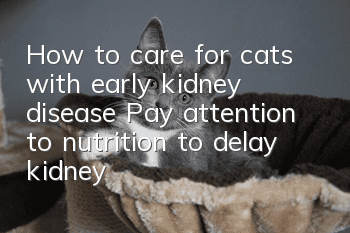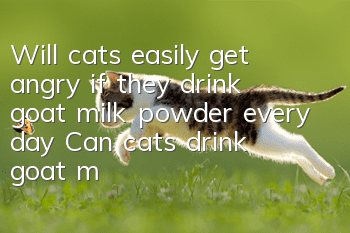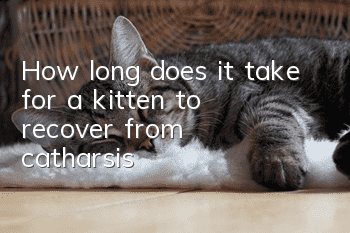How to care for cats with early kidney disease: Pay attention to nutrition to delay kidney disease

Chronic kidney disease is a progressive disease. Cats with kidney disease suffer from declining kidney function, causing the kidneys to be unable to function normally, and the body begins to develop various symptoms. Although chronic kidney disease is irreversible, if you change your daily routine, diet and treatment early, you can still help cats delay the decline of kidney function!
With the development of medical treatment and the advancement of feeding concepts, cats’ lifespan has been significantly extended. Research shows that the average life span of pet dogs and pet cats was about 10 years old in 2002; by 2016, it had been extended to 12 years old and 14 years old respectively. It shows that the proportion of elderly cats is increasing year by year, and age-related diseases have also received unprecedented attention.
One of the hardest working organs: kidneys
The kidneys of animals are in charge of metabolism, water and ion stability. Not only do they have to work hard, but they also have a huge workload, which keeps them high on the list of chronic diseases in pets.
In order to help pet doctors and pet care providers have a basis for reference and tracking indicators when controlling chronic kidney disease, the International Kidney Rights Organization has developed a consensus on pet chronic kidney disease to stage the process of the disease.
However, in addition to renal function, other systems will also affect the index of IRIS staging evaluation, and the scope of chronic kidney disease is very wide and complex, and various factors lead to certain differences in each cat's condition. Therefore, in addition to referring to the staging system when evaluating, a professional pet doctor still needs to make a more comprehensive consideration for the cat.
Detection and staging of chronic kidney disease in pets
As mentioned earlier, in addition to kidney function, dehydration is also one of the factors leading to abnormal renal index. Therefore, pet doctors will draw blood tests for animals when they are in a hydrated state (sufficient water content in the body), and Do periodic assessments.
The staging system can be divided into stages one to four based on kidney-related indices, such as blood urea nitrogen (BUN), serum creatinine (CREA), SDMA and other tests. The larger the number, the more advanced the stage, and also the kidney The more serious the disease is.
Compared with CREA, SDMA detection is a more sensitive index. When the kidney function only loses 25%, SDMA will increase; while CREA will not show abnormalities until the kidney function has lost 75%. Therefore, SDMA and CREA can be used simultaneously to help improve the early diagnosis of kidney disease.
In addition to using the detection index as a reference, urinary protein loss and hypertension are also sub-grades of chronic kidney disease, both of which will affect the course of the disease and treatment methods.
Diagnose chronic kidney disease early,Provide more appropriate nutritional support
Different stages of chronic kidney disease have different treatment recommendations, but the fundamental principle of controlling chronic kidney disease is: sustainable use.
1. Lower blood pressure and reduce kidney load to delay the deterioration of kidney function.
2. Strictly select protein intake to reduce the workload of kidney filtration and metabolism.
3. Reduce phosphorus intake to reduce the development of chronic kidney disease.
However, for cats with kidney disease, how much protein should be consumed is a very delicate issue: on the one hand, we hope that the cat’s kidneys can have a good rest; on the other hand, we do not want the cat to lose muscle mass and lose shape due to too little protein intake. Getting thinner and thinner.
At the same time, when the pet doctor calculates a balanced, nutritious and suitable diet for cats and dogs with kidney disease, another very real question will be involved: Are the cats willing to pay the bill? Although there are some appetite-stimulating drugs available, such as Cyproheptadine, Mirtazapine, Gabapentin, etc., food palatability is a very important consideration.
When a cat is detected to be at risk of chronic kidney disease, professional pet doctors recommend giving Royal Canin’s ER22 canine early kidney disease formula or ER28 feline early kidney disease formula, which contains appropriate phosphorus content, EPA and DHA, etc. The fatty acids, as well as the antioxidant complex, can provide precise nutritional support at the first signs of kidney damage, and its special aroma can also increase the cat's willingness to eat.
Finally, I would like to add: the factors that cause chronic kidney disease are not simple, but are often interrelated, eventually leading to a decline in kidney function.
Chronic kidney disease currently uses supportive treatment to reduce the burden on the kidneys. Although it is an irreversible disease, diet control and home care can still help cats slow down the decline of kidney function. For cats with kidney disease, a suitable diet is very important, but what is more important is that the cat is willing to eat and has sufficient drinking water, so that they can accompany you for a longer time!
- If you have no experience, what do you need to prepare for raising a cat for the first time?
- The right way to improve your cat’s hair
- A complete list of cute and unique cat names
- What to do about pyoderma in cats
- Will catnip stimulate cats to go into heat?
- How to guide cats to drink more water
- Can pregnant cats eat Sunuo tablets?
- Can I eat soy sauce and light soy sauce after being scratched by a cat?
- Why is the kitten's hind legs weak and unable to walk?
- Can cats eat peaches?



